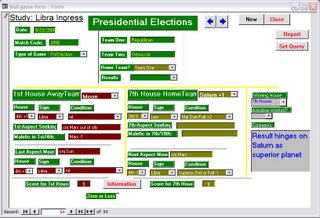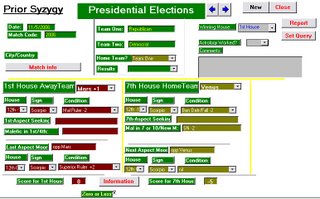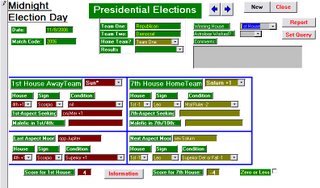The reason that I don't often make predictions about post-season baseball is that I'm too passionate about it. Strong emotions interfere with good predictions. Which is why most astrologers find themselves to be somewhat flummoxed with their own charts. The other area where strong emotion frequently gets in the way is politics: where almost everybody seems to have an opinion as strong or stronger than the most rabid sports fan pulling for his/her favorite team.
And so again: it's election season.
Well over a decade ago, I worked with Bernadette Brady to build a quantitative model for doing sports prediction based on the Medieval astrologer Guido Bonatti's rules of warfare. With this model, we were able to beat bookmaker's odds for both the cricket matches known as the Ashes (in Bernadette's case) and US football Superbowls in mine.
Shortly thereafter, I asked whether these models could be similarly applied to presidential elections. I did a study not only to determine if the warfare model in general worked (it did), but also which chart to use for the presidential election, as so many mundane possibilities existed. The three charts which historically produced the best results were:
Midnight election day
The prior lunation
The prior Libra Ingress (a contrarian model: i.e., it predicts in reverse)
Note: this article can be found at my web site under http://www.leelehman.com/downloads___references.html
Although this model was developed specifically for presidential elections, I have experimented in the past with applying it to presidential off-year elections. In this case, my hypothesis is that the same model that predicts the presidential result by party could predict whether the congressional elections show a net gain or loss for the party in power.
Therefore, in the spirit of this hypothesis, I present the predictions for 2006.
Here are the tabulations according to this model for the three different charts. Please click on any of the graphics to see a larger view.



The only chart here which may be unclear is the Libra Ingress, since the score is tied. The rule for tie-breaking is that the superior planet “wins;” thus all three models favor the Democrats. The conclusion is that the Democrats will gain seats: how much is not a function of the model.

2 comments:
I was wondering if I read a question at midnight, do I need to set an ascendant at 4th house(but, to contradict myself, the ascentant is always assigned a 1st house???). Do you know what i am talking about?
I think I do. You’ve raised an important point, Angel, because by definition, a midnight chart is going to have an approximately 4th house Sun placement (barring variations in longitude away from the time meridian line, daylight savings or war time, or polar locations). It’s one of those things you have to think about whenever you are looking at an event that recurs at a regular time or a regular date, there are features of the chart that you have to “cancel out” so to speak. For example, if you want to study the USA Superbowl, or the Kentucky Derby, these take place on a particular Sunday in February or Saturday in May respectively, at a time determined for maximal television viewing audience, so like this election chart, the position of the Sun is in a range of a few degrees, and generally in a particular house. This means that, strange as it sounds, you have to “throw out” the Sun position – at least as far as those components of its position repeat. So I cannot use the fact that the Sun is at the IC in a presidential or congressional election as predicting anything in the model, but I could use the Sun if the next aspect of the moon was to the Sun, because, here, the time of day and year isn’t a direct determining factor in the Moon’s movement.
Post a Comment